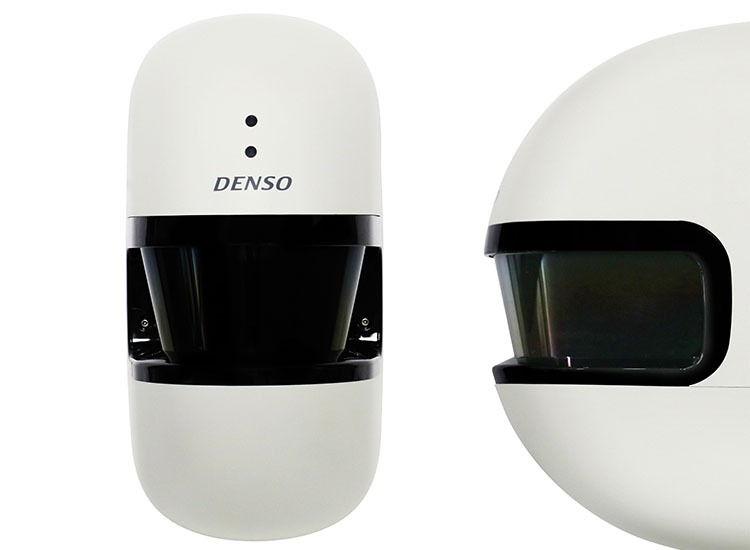SPONSORED CONTENT FROM DENSO
How Cities can profit from the Zone-D Sensor Security System from DENSO
Nowadays, safety and security risks are increasing in all aspects of life, both for individuals and in business. DENSO, part of Toyota group, has invented an innovative security system: the Zone-D. It detects accurately the position of moving objects, making it possible to protect all types of perimeters reliably.
Viv Bradshaw, Manager Business Development Europe and Technology Consultant at DENSO WAVE EUROPE, explains: “Often line and curtain type sensors are used in public places, but these models can only detect objects from point to point. Our Zone-D, however, covers not only a wide area but also detects on the surface, which makes it hard for intruders to avoid being detected.” Compared with a CCTV, the Zone-D auto-tracking system covers and records over a much wider range.
Intelligent Networking for more Security
If connected to security equipment like PTZ cameras, lights or sirens, the Zone-D is able to send signals and activate these devices, when detecting an object. The sensor can control PTZ cameras to track an object automatically and it is capable of differentiating between people, animals, cars, and other objects. The object filtering function enables false alarms to be avoided. Furthermore, it is reliable under all lighting conditions, as it can detect objects in the dark or at illuminances of up to 100,000 lux. Even rain and fog are no issue.
But how does it work exactly? The Zone-D detects surfaces of about 60 by 30 meters. They can be clustered in individually configurable zones, and thus, different areas can be set. For example, a green zone can be the safe area where no signal needs to be set for when objects are moving in this area. But if an area needs extra protection, this area can be marked as a red zone and an alarm can be activated when intruders enter. Up to 13 different zones are available, enabling the appropriate actions to be taken depending on the threat level. Additionally, the shape of the detection area can be set flexibly based on the user’s needs.
The monitoring system sends notifications immediately to the user’s computer or monitoring area. In detail, when an intruder is detected within the monitoring area, the camera automatically zooms in to track and record the intruder’s action. That is when an immediate email is sent to the user’s device. Another option for more protection is the damage prevention: In critical areas, intimidation systems such as lights, flashlights or sirens can be activated. Additionally, vocal warnings can be made remotely and electric locks can be engaged to prevent any damage inflicted on the public space all while viewing the intruder’s actions in real-time. Live videos can be verified with connected portable terminals such as PCs and smartphones.
Zone-D during the Corona Pandemic
In the current lockdown situation where social distancing is becoming the norm, the Zone-D can help enforce this. By defining detection zones, people can be detected in a particular zone. Should movement outside the zone be seen, the Zone-D can enable the playback of a pre-recorded message to help enforce social distancing. Additionally, a PTZ camera can track that person and any security or monitoring person can provide the human-touch instead.
Furthermore, the Zone-D supports ‘crossing detection lines.’ These can be used where entrances and exits are defined. For example, people can be detected, if they use the wrong route. This feature of the Zone-D can also be used to detect when a position at, for example, a ticketing booth becomes free, notifying the queue that the booth is available and enabling prompt use. Some example applications, especially during Corona, include border or passport control, supermarket entry queues, and ticketing at theme parks or conferences.
Various Application Areas
The application areas in which the Zone-D can be used, in addition to the needs during the Corona pandemic, are diverse. No matter the location – airports, power plants, factories, museums, car dealers, condominiums, and even parks – dangers are present everywhere. The laser sensor can perfectly be used in public spaces but also in residences.
In Japan, home of the Toyota group, the Zone-D has already been installed in approximately 500 projects. They have proven that the laser sensor is ideal for monitoring critical infrastructure, like railway crossings, train platforms, and airport perimeters, as well as water, electricity and gas installations.
“The security sector might be new to DENSO, but we have already shown that our product increases the protection in the areas where it is installed – and we are looking forward to protecting more companies and people with our innovative Zone-D,” Bradshaw sums up.
For more information, contact Tim Thompson, Head of Sales UK, Nordics & Benelux
Phone +44 192 64 26 173 | +44 121 2964 700
Mobile +44 791 715 6493
Email tim.thompson@denso-wave.eu
Or, visit: https://www.denso-wave.eu/en/denso-products/scanner/zone-d-laser-sensor.html

